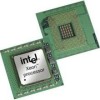Intel BX80605X3430 Data Sheet - Page 37
Enhanced Intel, SpeedStep, Technology, Low-Power Idle States
 |
UPC - 735858210331
View all Intel BX80605X3430 manuals
Add to My Manuals
Save this manual to your list of manuals |
Page 37 highlights
Power Management 4.2.1 Enhanced Intel® SpeedStep® Technology The following are the key features of Enhanced Intel SpeedStep Technology: • Multiple frequency and voltage points for optimal performance and power efficiency. These operating points are known as P-states. • Frequency selection is software controlled by writing to processor MSRs. The voltage is optimized based on the selected frequency and the number of active processor cores. - If in the target frequency is higher than steps to an optimized voltage. This the current frequency, voltage is signaled by tVhCeCVisIDr[a7m:0p]edpiunps to the voltage regulator. Once the voltage is established, the PLL locks on to the target frequency. - If the target frequency is lower than the current frequency, the PLL locks to the target frequency, then transitions to a lower voltage by signaling the target voltage on the VID[7:0] pins. - All active processor cores share the same frequency and voltage. In a multicore processor, the highest frequency P-state requested amongst all active cores is selected. - Software-requested transitions are accepted at any time. If a previous transition is in progress, the new transition is deferred until the previous transition is completed. • The processor controls voltage ramp rates internally to ensure glitch-free transitions. • Because there is low transition latency between P-states, a significant number of transitions per second are possible. 4.2.2 Low-Power Idle States When the processor is idle, low-power idle states (C-states) are used to save power. More power savings actions are taken for numerically higher C-states. However, higher C-states have longer exit and entry latencies. Resolution of C-states occur at the thread, processor core, and processor package level. Thread level C-states are available if Intel Hyper-Threading Technology is enabled. Figure 4-1. Idle Power Management Breakdown of the Processor Cores Thread 0 Thread 1 Thread 0 Thread 1 Core 0 State Core 1 State Processor Package State Datasheet, Volume 1 37















